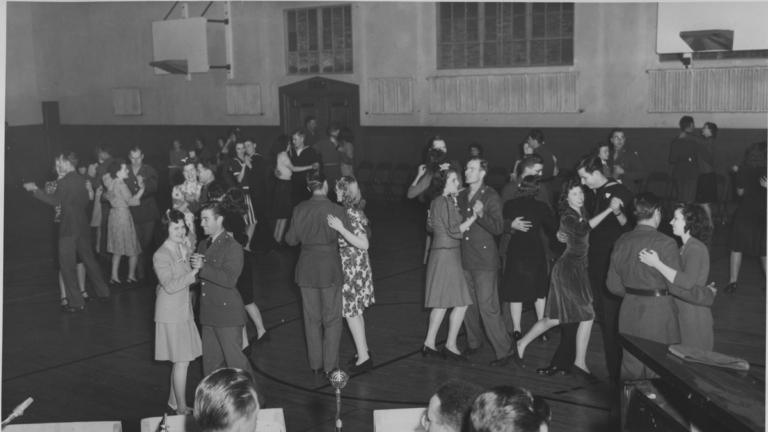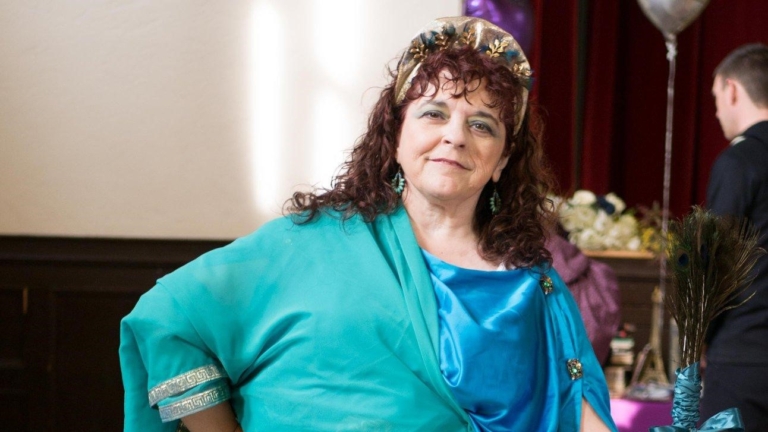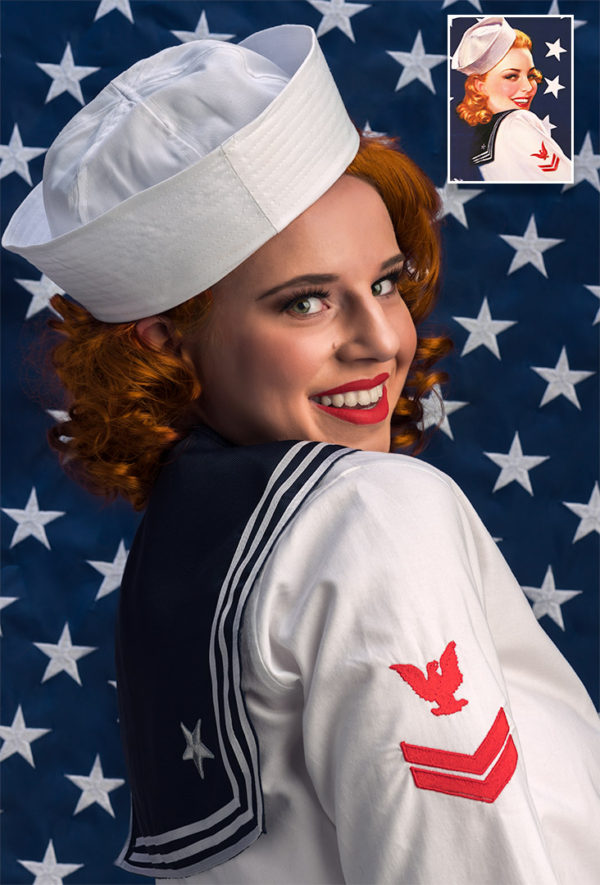Dressing for the 1940s USO Tea


Seattle Municipal Archives
By Kathe Gust
GBACG Membership Coordinator
There are two things I will not be addressing in this article. I won’t discuss military uniforms, because if you wear uniforms you likely know more about that than I do. If you want confirmation of your authenticity, I suggest you look for articles like this one by expert Byron Connell “WWII U.S. Army Officers’ Uniforms.” http://www.siwcostumers.org/newsletterarchive/VirtCostV9-I2-2011/VirtCostV9-I2-2011_37-army.pdf I’m also not planning to discuss mobsters/gangsters/floozies. I don’t think “doze guys ‘n’ dolls” would have been found at a USO tea.
It may be hard for many of us today to visualize the impact of World War II on the day-to-day lives of Americans. The war affected even those living in countries where battles were not actually fought. The whole world changed and so did fashion. Paris temporarily lost its role as a fashion setter and Hollywood took the lead for the decade.
Nylon and wool fabrics were both needed by the military. Japanese silk was banned in the USA after the attack on Pearl Harbor in 1941. Rayon became important as a replacement fiber for silk, and was mixed with wool for use in “Victory” suiting. Rubber restrictions meant that girdles disappeared, but it was easier to stay fashionably thin when food was also being rationed.
“Patriotic” colors like cadet blue, khaki, gray, navy and others were popular for clothing. Bright colors tended to be focused in accessories like hats and neckties.
For men and women, war rationing of fabric resulted in the most significant change in clothing styles. Although the shapes changed very little, vests, pocket flaps, and trouser pleats and cuffs were often removed to conserve material. People continued wearing their pre-war clothing as long as possible in an effort to leave new cloth available for uniforms, so men can still wear 1930s style three-piece suits if you prefer that look. Younger men seemed to be perfectly happy to leave waistcoats behind.
In fact, for men, most modern classic business suits will pass, but if you own one that makes you look like you have broader than actual shoulders, that’s a great choice for the ‘40s look. The ‘40s were all about big shoulders for both men and women. Nipped waists were also a trend for both sexes, so bring out the slim fit suit. It saved fabric and also made you look impressive! Lapels wider than today’s on men’s suits were also usual, so that’s another thing to look for if you are thrift shopping for a new suit. If you have flapped pockets, you could try tucking the flaps into the pockets for a “Victory” suit look.
Trousers had wider, straighter legs than now, about 20 inches around at the bottom and the two-inch cuff was a popular finish. Trousers were also worn much higher at the waist than we are currently accustomed to seeing. Reconstructing History offers pattern 1401 if you want to make your own. You can also search out men’s wide leg dress pants on Google to purchase them online from various vendors, or try vintage stores, being sure to check for both 1930s and 1940s era garments. Although cuffs were supposed to be forbidden, many men still found ways to have them, so that detail is still one of personal choice, as it was then.
Hint: You may be able to achieve a high-waisted trouser at less cost, if you are willing to sew. Buy the next size up. So, a 32-inch waist would buy a slightly larger 33-inch waist. Because the trouser proportions (especially the rise) will be made for someone bigger, the trousers will then sit higher on your body. Get the waist taken in, and you wind up with high waisted trousers! (If you pull the waist so it will fit in the back and the thighs look a bit like jodhpurs or peg pants it may be hard to get them right without redoing the side pockets. Don’t go there.) You can also thrift trousers in your size from 1940 to 1970 if you want the high-waisted look and aren’t worried about the leg taper. The length of the zipper will be a give away as to the rise. It will look longer than “normal.”

Sadler0
Men’s neckties during the 1940s were both shorter and wider than they are now (45-47 inches long, 3.5–5 inches wide). Plan for a two-inch gap above your waistband. The available colors and patterns were amazing. Some were just wild abstracts, but you can also find tie designs based on hobbies, as well as “tropical” designs. Hawaii was on the radar after Pearl Harbor and men supported that in their tie choices. You can still find those ties at antique shops and some thrift stores. Bow ties were a less popular option. There is a great blog post on patterned neckties of this decade on the Witness2 Fashion blog. http://witness2fashion.wordpress.com/2014/08/13/mens-necktie-patterns-1941-to-1950/ The color illustrations in the post are those used by McCall’s to advertise their patterns. A sure-fire way to give a ‘40s vibe to a modern suit is to invest in a great, rather bold, vintage necktie! Anything over $60 is way too much for a tie, unless it’s got some truly crazy detailing or other historical significance. Plain vanilla vintage stripes and foulards should be in the $20 range.
Suits, on the other hand, were pretty standard in color and pattern, though they wore more browns than are currently popular. Suits came in single- and double-breasted styles before the war, so you would still see both throughout the ‘40s despite the difficulty of justifying a new double-breasted coat after rationing began. People tended to keep their clothes for years. For example, it wouldn’t be uncommon to see an early ’30s suit still being worn in the 1940s. Some clothiers used essentially the same cut and fit for decades. Brooks Brothers’ style no.1 sack suit didn’t change until the 1970s. Sport coats became an acceptable business fashion. So, if you have separates, consider them. Tweeds, plaids and windowpane checks are good and there is always the camel or navy blazer.
Shirts could be white, colored or patterned, but not too bold. Tone-on-tone or regular stripes were one popular choice that look great and gives off vintage vibes worn with patterned ties. A spearpoint collar with a collar bar adds a nice touch. So do vintage tie clips. Choose only one! Yes, you can wear French cuffs and links. The 1940s was also a pocket square decade. It should be compatible, but need not (some say should not) match your tie. Points up, or a careless stuff–no nice square edges.
Don’t forget your hat. Gentlemen removed them indoors, but would not go out without a fedora, trilby, homburg or flat cap. Choose the one that suits your face best, but remember the cap is a more casual choice. You may want to pair that one with a sport coat instead of a suit. Men’s hair styles reflected the prevalent military influence. Even civilians wore it short on sides and back. The only length was on top, but that could be combed in several ways. Nextluxury offers a collection of men’s styles for your browsing pleasure. http://nextluxury.com/mens-style-and-fashion/1940s-hairstyles-for-men/ Mustaches were the most common type of facial hair worn by men of the time. The Clark Gable style pencil mustache was a popular option.
The Vintage Dancer website has a nice run-down on men’s clothing fashion http://vintagedancer.com/1940s/1940s-mens-fashion/ that you can read. It gives the low down on belts vs. suspenders, what shirt collars are most appropriate and what shoes to wear. It even discusses pocket squares. Remember, this event is a tea, so it’s probably not the best venue for casual or highly theatrical clothing. Sorry for all you Aloha shirt and Zoot suit fans.
Women’s wear of the 1940s had one very obvious reaction to rationing, hems went up! The common mid-calf hem of the ‘30s became knee length, and shoulder pads were added to everything, even blouses. A slim waist remained an important fashion focus. Narrow self-fabric or leather belts were a common feature of suits and dresses and helped shape the garment so it would present the desired hour-glass figure.
The bias cut disappeared, since it “wasted” fabric. Expensive lace and other trims were also not considered economical during wartime austerity. Sleeveless/backless looks were reserved for evening wear only. Life was serious now. It was not unusual for women to re-cut an old garment as a way to update it to the newer, military influenced styles.
Slacks for women did start appearing during the 1940s, but were considered an extreme style that was not really suitable outside factory work or some sporting venues until the 1950s.
Tea would be considered a daywear event, which means choosing an A-line dress with sleeves or a tailored suit. A variety of necklines were available to choose from, but all were modest–no cleavage showing. Even the v-necks of the 1940s did not expose anything below the collarbones!
Prints were popular but tended to be smaller in scale. Check the Pinterest images at http://www.pinterest.com/pin/45950858669869550/?lp=true for examples of vintage war year printed fabrics. Rayon or cotton was the fabric of choice for new dresses.
Front-buttoning shirtwaist styles were very popular as was the full button-down dress. To make it more interesting, if you are sewing your own, try an asymmetrical buttoning instead of just down the center, or use two or three large buttons on a shirtwaist instead of several smaller ones.
Wrap dresses also existed, some as full-length wraps and others only wrapping in the bodice. Full-length wrap styles could cross in either front or back and typically had snaps in the neck area to keep the modest necklines closed on front wrapping versions.

NASA on the Commons
Regardless of your dress choice, remember a lady would always wear gloves to special events and of course, a charming chapeau. Hats were not rationed, but the 33% luxury tax on them insured that hats from the 1930s continued to be worn. Newer hats were simpler in style or were smaller and attached to the head in clever ways with hat pins or straps. Turbans were big news since they covered messy hair for working women. Serious hats were borrowed from menswear to make ladies’ versions of the Fedora and Homburg. Snoods were popular for more casual functions, but could be upscaled in material, such as metallic yarn or sequined, for fancier events. They also combined well with some hats.
A very complete selection of 1940s hat images is available at The Vintage Dancer. http://vintagedancer.com/1940s/1940s-hats/ Vogue also offers patterns for hats similar to some from the 1940s–look for numbers 7325, 7464, 7657 or 8175.
Women’s reproduction clothing for the 1940s should be carefully chosen. Many items today are “inspired” by 1940s shapes, but fail the basic day dress test by being either sleeveless or too bare in the bodice, not to mention the wrong length and sometime having too wide a skirt. By all means feel free to check Unique Vintage, Retro Stage and Dresslily but choose carefully. The customizable dresses at eShakti may actually be a good choice if you see something there you like. You can often alter the neckline and add sleeves (and pockets!) to eShakti dresses.
Men can take a look at Paul Frederick. http://www.paulfredrick.com/ You can create an entire vintage men’s look from just this one catalog. Some suits listed do have somewhat wider lapels and broader shoulders.
It is trickier to find vintage 40s clothes, we tend to be larger than they were back then–so vintage can be difficult, still you can try. Antiques stores sometimes have vintage attire, but they will be serendipitous finds. Most of them have only a small selection if any. Men should also check the late 1980s vintage when there was a revival of wide lapels and neckties.
Rusty Zipper http://www.rustyzipper.com/ has some 1940s vintage for men and women at reasonable prices. You can search by era.
Over Attired Vintage http://www.etsy.com/shop/OverAttiredVintage caters to all genders.
You can choose from a whole list of Bay Area Men’s vintage stores that have been reviewed on Yelp! Most of them serve all genders, but it is harder to find men’s vintage, so that was the search I tried. http://www.yelp.com/search?find_desc=mens%20vintage%20clothing&find_loc=San%20Francisco%20Bay%20Area%2C%20CA
Etsy/Ebay–there are pattern sellers and many, many vintage clothing sellers on these services. Prices tend to be lower for vintage in the central and midwestern states. Do be sure to check sizes before you buy! A simple search like men’s (or women’s) 1940s turns up many options, but you can also focus it by adding hat, shoes, dress, trousers, suit, etc.
When all you have are flat garment measurements to go by, remember to allow for wearing ease. Make sure you have at least the minimum or you won’t be comfortable and may damage the vintage garment. Larger persons should aim for the maximum ease, so they can move comfortably. Typical ease, for fitted non-stretch fabrics, is 2-4 inches extra in the chest, 1 to 1.5 inches extra in the waist, 2-4 inches extra in the hips. For a jacket, use 1.5-2 extra inches, since it needs to float over a shirt or blouse. For a coat, that might be worn over a suit, allow more.
Let me point out that ease also varies with personal comfort levels. Some people don’t mind a little restriction to achieve a particular look, while others prioritize personal comfort over appearance.
Also, marked women’s sizes have changed since the 1940s. A dress marked size 12 back then would be considered a size 6 today, an 8 in today’s sizing would have been a 16. When in doubt ask the seller for flat measurements. There is a great blog post that discusses this topic more fully at Chronically Vintage. http://www.chronicallyvintage.com/2013/01/vintage-clothing-sizing-101.html Men have it easier, since their sizes have been based on actual measurements, not some mythical standard body.

Photo by Howard L. Hollem
If you want to see ‘40s fashion in action try some of these films:
1942 – Casablanca: Bogie rocks the tough guy look as Rick, Ingrid is Ilsa. Both are icons of style.
1944 – Double Indemnity: Fred MacMurray–hottie or dupe? Barbara Stanwyck is a bad woman with great clothes.
1944 – Laura: Working guy Dana Andrews vs. dandy Clifton Webb, not to mention Gene Tierney’s graphic designer stylings.
1944 – Arsenic and Old Lace: Cary Grant is a bachelor author. Priscilla Lane is a minister’s daughter. Don’t ask what the aunts are up to.
1945 – Mildred Pierce: Joan Crawford melodrama with shoulder pads and pies. Joan’s fur coat was extremely influential.
1945 – Leave Her to Heaven: Gene Tierney obsesses over Cornel Wilde.
1946 – Maltese Falcon: Bogart again, with the lovely Mary Astor and a statue.
1947 – Miracle on 34th Street: Watch John Payne as a fledgling lawyer and all the guys who work at Macy’s. Maureen O’Hara is a working mom and there are plenty of kids waiting to see Santa.
As a special treat there is a (sorta true) movie about an actual WWII USO tour, “Four Jills in a Jeep” (1944). Kay Francis, Carole Landis, Martha Raye and Mitzi Mayfair as themselves, re-enact their five-month USO tour of Europe and North Africa during World War II. The plot is slimmer than the book of the same name, but you get some idea of the hard work the USO tours did.
If you noticed that popular star James Stewart is not listed, that’s because the man who would eventually become Brigadier General Stewart was serving with distinction in the U.S. Air Force for most of the decade.
Books:
Everyday Fashions of the 1940s as Pictured in Sears Catalogs by JoAnne Olian. 122 fully illustrated and captioned pages selected and reproduced from rare copies of Sears catalogs of the World War II era
Forties Fashion: From Siren Suits to the New Look by Jonathan Walford. Illustrations reveal a wide range of fashions and styles from the 1940s in North America, Europe, Australasia and Japan.
Fashions of a Decade, the 1940s by Patricia Baker. Part of an illustrated fashion history series designed for young people.
Blueprints of Fashion Home Sewing Patterns of the 1940s by Wade Laboissonniere. 550 color photographs of pattern envelopes from companies like Advance, Butterick, Hollywood, McCalls, Simplicity, Vogue and others.


Liz
Simplicity.com offers what I believe are the authentic patterns they sold back in the day. They offer Vogue, Butterick, McCall’s, & Simplicity as well as a few others. They run frequent sales that are usually $6.99 for Vogue, $4.99 for Butterick & McCall’s, & $2.99 for Simplicity. If you sew, good deals are to be had.